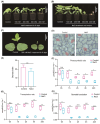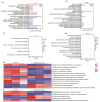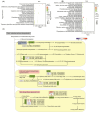Integrated Transcriptomic, Proteomic, and Metabolomic Analyses Revealed Molecular Mechanism for Salt Resistance in Soybean (Glycine max L.) Seedlings
- PMID: 39769326
- PMCID: PMC11678865
- DOI: 10.3390/ijms252413559
Integrated Transcriptomic, Proteomic, and Metabolomic Analyses Revealed Molecular Mechanism for Salt Resistance in Soybean (Glycine max L.) Seedlings
Abstract
Salt stress poses a significant challenge to plant growth and restricts agricultural development. To delve into the intricate mechanisms involved in soybean's response to salt stress and find targets to improve the salt resistance of soybean, this study integrated transcriptomic, proteomic, and metabolomic analyses to explore the regulatory networks involved in soybean salt tolerance. Transcriptomic analysis revealed significant changes in transcription factors, hormone-related groups, and calcium ion signaling. Notably, the biosynthetic pathways of cutin, suberine, and wax biosynthesis play an important role in this process. Proteomic results indicated salt-induced DNA methylation and the enrichment of phosphopyruvate hydrase post-salt stress, as well as its interaction with enzymes from various metabolic pathways. Metabolomic data unveiled the synthesis of various metabolites, including lipids and flavonoids, in soybean following salt stress. Furthermore, the integrated multiomics results highlighted the activation of multiple metabolic pathways in soybean in response to salt stress, with six pathways standing out prominently: stilbenoid, diarylheptanoid, and gingerol biosynthesis; carotenoid biosynthesis; carbon fixation in photosynthetic organisms; alanine, aspartate, and glutamate metabolism; thiamine metabolism; and pyruvate metabolism. These findings not only offer valuable insights into leveraging multiomics profiling techniques for uncovering salt tolerance mechanisms but also identify candidate genes for soybean improvement.
Keywords: DNA methylation; RNA-seq; abiotic stress; cuticle biosynthesis; multiomics.
Conflict of interest statement
The authors declare that they have no known competing financial interests or personal relationships that could have appeared to influence the work reported in this paper.
Figures









Similar articles
-
Comparative Transcriptome Analysis of Salt-Tolerant and -Sensitive Soybean Cultivars under Salt Stress.Int J Mol Sci. 2024 Sep 11;25(18):9818. doi: 10.3390/ijms25189818. Int J Mol Sci. 2024. PMID: 39337306 Free PMC article.
-
Integrated Physiological, Transcriptomic, and Metabolomic Analyses Revealed Molecular Mechanism for Salt Resistance in Soybean Roots.Int J Mol Sci. 2021 Nov 27;22(23):12848. doi: 10.3390/ijms222312848. Int J Mol Sci. 2021. PMID: 34884654 Free PMC article.
-
Elucidating the role of exogenous melatonin in mitigating alkaline stress in soybeans across different growth stages: a transcriptomic and metabolomic approach.BMC Plant Biol. 2024 May 8;24(1):380. doi: 10.1186/s12870-024-05101-9. BMC Plant Biol. 2024. PMID: 38720246 Free PMC article.
-
Enhanced Salt Tolerance of Rhizobia-inoculated Soybean Correlates with Decreased Phosphorylation of the Transcription Factor GmMYB183 and Altered Flavonoid Biosynthesis.Mol Cell Proteomics. 2019 Nov;18(11):2225-2243. doi: 10.1074/mcp.RA119.001704. Epub 2019 Aug 28. Mol Cell Proteomics. 2019. PMID: 31467032 Free PMC article.
-
Multi-omics analysis reveals the regulatory mechanism of branching development in Quercus fabri.J Proteomics. 2025 Mar 20;313:105373. doi: 10.1016/j.jprot.2024.105373. Epub 2025 Jan 6. J Proteomics. 2025. PMID: 39778766 Review.
Cited by
-
Comparative Transcriptome Analysis of Gene Responses of Salt-Tolerant and Salt-Sensitive Watermelon Cultivars' Roots to Salt Stress.Plants (Basel). 2025 Mar 24;14(7):1013. doi: 10.3390/plants14071013. Plants (Basel). 2025. PMID: 40219081 Free PMC article.
References
-
- Kraamwinkel C.T., Beaulieu A., Dias T., Howison R.A. Planetary limits to soil degradation. Commun. Earth Environ. 2021;2:249. doi: 10.1038/s43247-021-00323-3. - DOI
-
- Panta S., Flowers T., Lane P., Doyle R., Haros G., Shabala S. Halophyte agriculture: Success stories. Environ. Exp. Bot. 2014;107:71–83. doi: 10.1016/j.envexpbot.2014.05.006. - DOI
MeSH terms
Substances
Grants and funding
LinkOut - more resources
Full Text Sources

